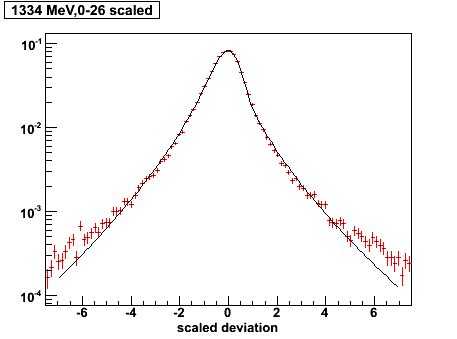Energy Dispersion
The energy dispersion is of order 10%, while the LAT energy band is approximatly 4 orders of magnitude (30 MeV to 300 GeV). Therefore, in many applications the energy dispersion can be neglected.
Default binning is 4 energy bins per decade, from 1.25 to 5.75 in McLogEnergy, 8 angle bins, equally spaced from 0.2 to 1.0 in cos(θ). For each bin, a _scaled energy dispersion_ is calculated, binned into a histogram, and then fitted as described below. First, we define
![]()
where the scaling factor depends on both true energy and true incidence angle:
![]()
All 6 parameters have distinct values for front and back events:
| c0 | c1 | c2 | c3 | c4 | c5 | |
|---|---|---|---|---|---|---|
| front | 0.0210 | 0.0580 | -0.207 | -0.213 | 0.042 | 0.564 |
| back | 0.0215 | 0.0507 | -0.220 | -0.243 | 0.065 | 0.584 |
As an example, here is a histogram of this scaled deviation x, with the fitting function superimposed:

The functional form of the analytical description of the LAT's Energy Dispersion Function is:

where the parameter NS is calculated requiring continuity at | x-x_BIAS | = 0.8 as follows:
![]()
Given a noticeable left/right asymmetry, the curve is actually parametrized separately left and right of the split point X_BIAS, so we have separate left and right width parameters S1 and S2 (and NS).
Note that the likelihood fitting tool gtlike does not include the energy dispersion in the fit. So long as the effective area is relatively flat (for example above 200 MeV) and you are not trying to resolve spectral features on a scale similar to the 6-15% energy resolution of the instrument, this causes a bias of at most 1-2% on the flux as a function of energy and similarly small biases on the spectral index and flux.
On the other hand, below about 200 MeV the effective area in P6_V11_DIFFUSE does change fairly rapidly. Coupled with the energy dispersion this causes biases in the measured flux as a function of energy, and which depend on the spectral hardness of the source in question.

» Forward to LAT Sensitivity
» Back to Effective Area
» Back to the beginning of the IRFs
» Back to the beginning of the Cicerone

